 W
WThe ABC Islands bear or Sitka brown bear is a subspecies or population of brown bear that resides in Southeast Alaska and is found on Admiralty Island, Baranof Island, and Chichagof Island of Alaska. These islands have the colloquial name of the ABC Islands and are a part of the Alexander Archipelago. This brown bear population has a unique genetic structure, which relates them not only to brown bears but to polar bears as well. Its habitat exists within the Tongass National Forest, which is part of the perhumid rainforest zone.
 W
WThe Alaska moose, or Alaskan moose in Alaska, or giant moose and Yukon moose in Canada, is a subspecies of moose that ranges from Alaska to western Yukon. The Alaska moose is the largest North American subspecies of moose. Alaska moose inhabit boreal forests and mixed deciduous forests throughout most of Alaska and most of Western Yukon. Like all moose species, the Alaska moose is usually solitary but sometimes will form small herds. Typically, they only come into contact with other moose for mating or competition for mates. The males and females select different foraging habitats leading to spatial segregation throughout much of the year. During mating season, in autumn and winter, male Alaska moose become very aggressive and prone to attacking when startled.
 W
WThe Alaska Peninsula brown bear or "peninsular grizzly" is a colloquial nomenclature for a brown bear that lives in the coastal regions of southern Alaska, although according to other sources, it is a population of the mainland grizzly bear subspecies, or the Kodiak bear subspecies.
 W
WThe Alaskan tundra wolf, also known as the barren-ground wolf, is a North American subspecies of gray wolf native to the barren grounds of the Arctic coastal tundra region. It was named in 1912 by Gerrit Smith Miller, who noted that it closely approaches the Great Plains wolf in skull and tooth morphology, though possessing a narrower rostrum and palate. It is a large, white-colored wolf closely resembling C. l. pambasileus, though lighter in color. This wolf is recognized as a subspecies of Canis lupus in the taxonomic authority Mammal Species of the World (2005).
 W
WThe Arctic ground squirrel is a species of ground squirrel native to the Arctic and Subarctic of North America and Asia. People in Alaska, particularly around the Aleutians, refer to them as "parka" squirrels, most likely because their pelt is good for the ruff on parkas and for clothing.
 W
WThe Arctic lemming is a species of rodents in the family Cricetidae.
 W
WThe Arctic shrew, also known as the blackback shrew or saddlebacked shrew, is a medium-sized shrew found in Canada and the northern United States. Separate species status has been proposed for the maritime shrew which is found in New Brunswick and Nova Scotia and had been considered to be a subspecies of the Arctic shrew. The tundra shrew was formerly considered to be a subspecies of the Arctic shrew.
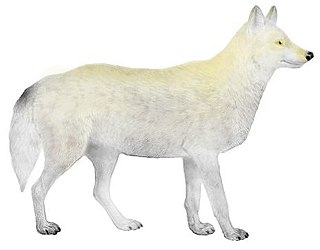 W
WThe Baffin Island wolf, also known as the Baffin Island tundra wolf, is a subspecies of gray wolf which resides exclusively on Baffin Island and several nearby islands. It was not formally recognized as a subspecies until 1943, when it was given its taxonomic classification by Anderson. This wolf is recognized as a subspecies of Canis lupus in the taxonomic authority Mammal Species of the World (2005).
 W
WThe barren ground shrew is a small shrew found in northern Canada west of Hudson Bay and in Alaska. At one time, this species was considered to be a subspecies of the similar cinereus shrew. It is similar in appearance and thought to be closely related to the Saint Lawrence Island shrew and Pribilof Island shrew.
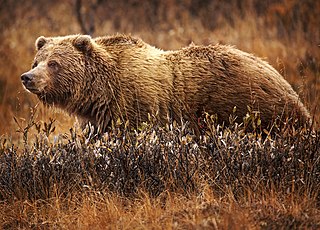 W
WThe grizzly bear, also known as the North American brown bear or simply grizzly, is a large population or subspecies of the brown bear inhabiting North America.
 W
WThe brown bear is a large bear species found across Eurasia and North America. In North America, the populations of brown bears are called grizzly bears. It is one of the largest living terrestrial members of the order Carnivora, rivaled in size only by its closest relative, the polar bear, which is much less variable in size and slightly bigger on average. The brown bear's range includes parts of Russia, Central Asia, China, Canada, the United States, Hokkaido, Scandinavia, the Balkans, the Picos de Europa and the Carpathian region, especially Romania, Bulgaria, Iran, Anatolia and the Caucasus. The brown bear is recognized as a national and state animal in several European countries.
 W
WThe barren-ground caribou is a subspecies of the reindeer that is found mainly in the Canadian territories of Nunavut and the Northwest Territories, as well as in Kitaa, Greenland. It sometimes includes the similar-looking Porcupine caribou, in which case the barren-ground caribou is also found in Alaska. The barren-ground caribou is a medium-sized caribou, smaller and lighter-coloured than the boreal woodland caribou, with the females weighing around 90 kg (200 lb) and the males around 150 kg (330 lb). However, on some of the smaller islands, the average weight may be less. The large migratory herds of barren-ground caribou take their names from the traditional calving grounds, such as the Ahiak herd, the Baffin Island herds, the Bathurst herd, the Beverly herd, the Bluenose East herd, the Bluenose West herd, the Porcupine herd and the Qamanirjuaq herd.
 W
WThe Peary caribou is a subspecies of caribou found in the High Arctic islands of Nunavut and the Northwest Territories in Canada. They are the smallest of the North American caribou, with the females weighing an average of 60 kg (130 lb) and the males 110 kg (240 lb). In length the females average 1.4 m and the males 1.7 m.
 W
WThe Arctic fox, also known as the white fox, polar fox, or snow fox, is a small fox native to the Arctic regions of the Northern Hemisphere and common throughout the Arctic tundra biome. It is well adapted to living in cold environments, and is best known for its thick, warm fur that is also used as camouflage. In the wild, most individuals do not live past their first year but some exceptional ones survive up to 11 years. Its body length ranges from 46 to 68 cm, with a generally rounded body shape to minimize the escape of body heat.
 W
WThe red fox is the largest of the true foxes and one of the most widely distributed members of the order Carnivora, being present across the entire Northern Hemisphere including most of North America, Europe and Asia, plus parts of North Africa. It is listed as least concern by the IUCN. Its range has increased alongside human expansion, having been introduced to Australia, where it is considered harmful to native mammals and bird populations. Due to its presence in Australia, it is included on the list of the "world's 100 worst invasive species".
 W
WThe common frog, also known as the European common frog, European common brown frog, or European grass frog, is a semi-aquatic amphibian of the family Ranidae, found throughout much of Europe as far north as Scandinavia and as far east as the Urals, except for most of Iberia, southern Italy, and the southern Balkans. The farthest west it can be found is Ireland. It is also found in Asia, and eastward to Japan.
 W
WThe moor frog is a slim, reddish-brown, semiaquatic amphibian native to Europe and Asia. It is a member of the family Ranidae, or true frogs.
 W
WThe wood frog has a broad distribution over North America, extending from the boreal forest of the north to the southern Appalachians, with several notable disjunct populations including lowland eastern North Carolina. The wood frog has garnered attention by biologists over the last century because of its freeze tolerance, relatively great degree of terrestrialism, interesting habitat associations, and relatively long-range movements.
 W
WThe snow goose, consisting of both a white morph and dark morph, is a North American species of goose, collectively with Ross's goose often referred to as "white geese" or "light geese." Its name derives from the typically white plumage. Many taxonomic authorities placed this species and the other "white geese" in the genus Chen. Most authorities now follow the traditional treatment of placing these species in the "gray goose" genus Anser.
 W
WThe gyrfalcon, the largest of the falcon species, is a bird of prey. The abbreviation gyr is also used. It breeds on Arctic coasts and tundra, and the islands of northern North America and the Eurosiberian region. It is mainly a resident there also, but some gyrfalcons disperse more widely after the breeding season, or in winter. Individual vagrancy can take birds for long distances. Its plumage varies with location, with birds being coloured from all-white to dark brown. These colour variations are called morphs. Like other falcons, it shows sexual dimorphism, with the female much larger than the male. For centuries, the gyrfalcon has been valued as a hunting bird. Typical prey includes the ptarmigan and waterfowl, which it may take in flight; it also takes fish and mammals.
 W
WThe Alaskan hare, also known as the tundra hare, is a species of mammal in the family Leporidae. They do not dig burrows and are found in the open tundra of western Alaska and the Alaska Peninsula in the United States. They are solitary for most of the year except during mating season, when they produce a single litter of up to eight young. Predators include birds of prey and polar bears, as well as humans for sport hunting.
 W
WThe Arctic hare is a species of hare, which is highly adapted to living in the Arctic tundra and other icy biomes. The Arctic hare survives with shortened ears and limbs,a small nose,fat that makes up close to 20% of its body, and a thick coat of fur. It usually digs holes in the ground or under snow to keep warm and to sleep. Arctic hares look like rabbits but have shorter ears, are taller when standing and, unlike rabbits, can thrive in extreme cold. They can travel together with many other hares, sometimes huddling with dozens or more, but are usually found alone, sometimes taking more than one partner. The Arctic hare can run up to 60 kilometres per hour (40 mph).
 W
WThe snowshoe hare, also called the varying hare, or snowshoe rabbit, is a species of hare found in North America. It has the name "snowshoe" because of the large size of its hind feet. The animal's feet prevent it from sinking into the snow when it hops and walks. Its feet also have fur on the soles to protect it from freezing temperatures.
 W
WThe High Arctic camel, from the mid-Pliocene epoch, is a fossil camel related to the fossil genus Paracamelus from which modern camels arose. It is also related to the extinct Ice Age Yukon giant camel. Collagen-containing fossils were found in 2006 near Strathcona Fiord on Ellesmere Island in Nunavut, Canada. The High Arctic camel lived at least 3.4 million years ago during a warmer period in a boreal-type forest environment.
 W
WA lemming is a small rodent, usually found in or near the Arctic in tundra biomes. Lemmings make up the subfamily Arvicolinae together with voles and muskrats, which form part of the superfamily Muroidea, which also includes rats, mice, hamsters, and gerbils. In popular culture, a longstanding myth holds that they commit mass suicide.
 W
WThe North American brown lemming is a small North American lemming. Originally called the Siberian brown lemming they were later formed into two distinct species.
 W
WThe viviparous lizard, or common lizard, Zootoca vivipara, is a Eurasian lizard. It lives farther north than any other species of non-marine reptile, and most populations are viviparous, rather than laying eggs as most other lizards do. It is the only species in the monotypic genus Zootoca. Both "Zootoca" and "vivipara" mean "live birth," in Greek and Latin respectively. It was called Lacerta vivipara until the genus Lacerta was split into nine genera in 2007 by Arnold, Arribas & Carranza.
 W
WThe Canada lynx is a medium-sized North American wildcat that ranges across Alaska, Canada and many of the contiguous United States. It is characterized by its long, dense fur, triangular ears with black tufts at the tips, and broad, snowshoe-like paws. As in the bobcat, the lynx's hindlimbs are longer than the forelimbs, so the back slopes downward to the front. The Canada lynx stands 48–56 cm (19–22 in) tall at the shoulder and weighs between 5 and 17 kg. The lynx is a good swimmer and an agile climber. The Canada lynx was first described by Robert Kerr in 1792. Three subspecies have been proposed, but their validity is doubted.
 W
WThe Eurasian lynx is a medium-sized wild cat native to Northern, Central and Eastern Europe to Central Asia and Siberia, the Tibetan Plateau and the Himalayas. It inhabits temperate and boreal forests up to an elevation of 5,500 m (18,000 ft). Despite its wide distribution, it is threatened by habitat loss and fragmentation, poaching and depletion of prey.
 W
WThe Alaska marmot, also known as the Brooks Range marmot or the Brower's marmot, is a species of rodent in the family Sciuridae. It is found in the scree slopes of the Brooks Range, Alaska. They eat grass, flowering plants, berries, roots, moss, and lichen. These marmots range from about 54 centimetres (21 in) to 65 centimetres (26 in) in length and 2.5 kilograms (5.5 lb) to 4 kilograms (8.8 lb) in weight. Alaska celebrates every February 2 as "Marmot Day," a holiday intended to observe the prevalence of marmots in that state and take the place of Groundhog Day.
 W
WThe hoary marmot is a species of marmot that inhabits the mountains of northwest North America. Hoary marmots live near the tree line on slopes with grasses and forbs to eat and rocky areas for cover.
 W
WThe mountain hare, also known as blue hare, tundra hare, variable hare, white hare, snow hare, alpine hare, and Irish hare, is a Palearctic hare that is largely adapted to polar and mountainous habitats.
 W
WThe muskox, also spelled musk ox and musk-ox, is an Arctic hoofed mammal of the family Bovidae, noted for its thick coat and for the strong odor emitted by males during the seasonal rut, from which its name derives. This musky odor is used to attract females during mating season. Its Inuktitut name "umingmak" translates to "the bearded one". Its Woods Cree names "mâthi-môs" and "mâthi-mostos" translate to "ugly moose" and "ugly bison", respectively. Muskoxen primarily live in Greenland and the Canadian Arctic of the Northwest Territories and Nunavut, with introduced populations in the American state of Alaska, the Canadian territory of Yukon, the Scandinavian Peninsula, and Siberia.
 W
WThe muskrat, the only species in genus Ondatra and tribe ondatrini, is a medium-sized semiaquatic rodent native to North America and an introduced species in parts of Europe, Asia, and South America. The muskrat is found in wetlands over a wide range of climates and habitats. It has important effects on the ecology of wetlands, and is a resource of food and fur for humans.
 W
WNelson's collared lemming is a species of rodent in the family Cricetidae. It is found in western and southwestern Alaska in the United States.
 W
WThe northern collared lemming or Nearctic collared lemming, sometimes called the Peary Land collared lemming in Canada, is a small North American lemming. At one time, it was considered to be a subspecies of the Arctic lemming. Some sources believe several other species of collared lemmings found in North America are actually subspecies of D. groenlandicus.
 W
WThe reindeer, also known as the caribou in North America, is a species of deer with circumpolar distribution, native to Arctic, sub-Arctic, tundra, boreal, and mountainous regions of northern Europe, Siberia, and North America. This includes both sedentary and migratory populations. Rangifer herd size varies greatly in different geographic regions. The Taimyr herd of migrating Siberian tundra reindeer in Russia is the largest wild reindeer herd in the world, varying between 400,000 and 1,000,000. What was once the second largest herd is the migratory boreal woodland caribou George River herd in Canada, with former variations between 28,000 and 385,000. As of January 2018, there are fewer than 9,000 animals estimated to be left in the George River herd, as reported by the Canadian Broadcasting Corporation. The New York Times reported in April 2018 of the disappearance of the only herd of southern mountain caribou in the contiguous United States with an expert calling it "functionally extinct" after the herd's size dwindled to a mere three animals.
 W
WThe European roe deer, also known as the western roe deer, chevreuil, or simply roe deer or roe, is a species of deer. The male of the species is sometimes referred to as a roebuck. The roe deer is relatively small, reddish and grey-brown, and well-adapted to cold environments. The species is widespread in Europe, from the Mediterranean to Scandinavia, from Scotland to the Caucasus, and east to northern Iran and Iraq. It is distinct from the somewhat larger Siberian roe deer.
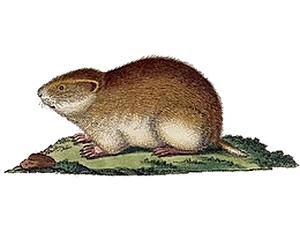 W
WThe Siberian brown lemming is a species of rodents in the family Cricetidae found in the Russian Federation. It does not hibernate during winter; it lives in burrows. It is prey to several animals, including the snowy owl and the Arctic fox. The lemmings are known for their high-amplitude, large-scale fluctuations of population sizes.
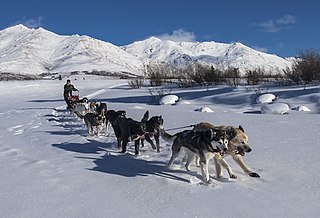 W
WSled dogs have been used in the Arctic for at least 9,000 years and were important for transportation in Arctic areas until the introduction of semi-trailer trucks, snowmobiles and airplanes in the 20th century, hauling supplies in areas that were inaccessible by other methods. They were used with varying success in the explorations of both poles, as well as during the Alaskan gold rush. Sled dog teams delivered mail to rural communities in Alaska, Yukon, Northwest Territories and Nunavut. Sled dogs today are still used by some rural communities, especially in areas of Alaska and Canada as well much of Greenland. They are used for recreational purposes and racing events, such as the Iditarod Trail and the Yukon Quest.
 W
WThe stoat or short-tailed weasel, also known as the ermine, is a mustelid native to Eurasia and North America. Because of its wide circumpolar distribution, it is listed as Least Concern on the IUCN Red List.
 W
WThe Svalbard reindeer is a small subspecies of reindeer found on the Svalbard archipelago of Norway. Males average 65–90 kg in weight, females 53–70 kg, while for other reindeer generally body mass is 159–182 kg for males and 80–120 kg for females.
 W
WThe Ungava brown bear is an extinct population of grizzly bears that inhabited the forests of northern Quebec and Labrador until the early 20th century, and is thus also known as the "Labrador grizzly bear", and "Labrador-Ungava grizzly", and due to one of the first scientific evidences for its existence coming from Okak Island, the "Okak grizzly". Reports of its existence were doubtful at best, until a skull was unearthed by anthropologist Steven Cox in 1975.
 W
WThe Ungava collared lemming or Labrador collared lemming is a small North American lemming.
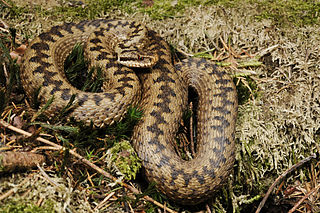 W
WVipera berus, the common European adder or common European viper, is a venomous snake that is extremely widespread and can be found throughout most of Western Europe and as far as East Asia. Known by a host of common names including common adder and common viper, adders have been the subject of much folklore in Britain and other European countries. They are not regarded as especially dangerous; the snake is not aggressive and usually bites only when really provoked, stepped on, or picked up. Bites can be very painful, but are seldom fatal. The specific name, berus, is New Latin and was at one time used to refer to a snake, possibly the grass snake, Natrix natrix.
 W
WThe northern red-backed vole is a small slender vole found in Alaska, northern Canada, Scandinavia and northern Russia.
 W
WThe singing vole, is a medium-sized vole found in northwestern North America, including Alaska and northwestern Canada.
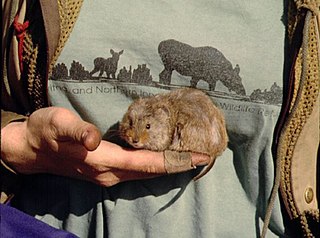 W
WThe taiga vole is a large vole found in northwestern North America, including Alaska and northwestern Canada. The name "taiga vole" comes from its living in the boreal taiga zone. It is also sometimes called the yellow-cheeked vole or chestnut-cheeked vole because of the rusty-yellow color on its face around its vibrisae (whiskers); The taiga voles derive their name from these features: "xantho" is Greek for yellow and "gnathus" is Greek for jaw. It is typically much larger than most other North American voles, especially those from the genus Microtus.
 W
WThe tundra vole or root vole is a medium-sized vole found in Northern and Central Europe, Asia, and northwestern North America, including Alaska and northwestern Canada. In the western part of the Netherlands, the tundra vole is a relict from the ice age and has developed to the subspecies Microtus oeconomus arenicola.
 W
WThe least weasel, little weasel, common weasel, or simply weasel in the UK and much of the world, is the smallest member of the genus Mustela, family Mustelidae and order Carnivora. It is native to Eurasia, North America and North Africa, and has been introduced to New Zealand, Malta, Crete, Bermuda, Madeira Island, the Azores, the Canary Islands, São Tomé, the Falkland Islands, Argentina and Chile. It is classified as least concern by the IUCN, due to its wide distribution and large population throughout the Northern Hemisphere.
 W
WThe Arctic wolf, also known as the white wolf or polar wolf, is a subspecies of grey wolf native to Canada's Queen Elizabeth Islands, from Melville Island to Ellesmere Island. It is a medium-sized subspecies, distinguished from the northwestern wolf by its smaller size, its whiter colouration, its narrower braincase, and larger carnassials. Since 1930, there has been a progressive reduction in size in Arctic wolf skulls, which is likely the result of wolf-dog hybridization.
 W
WThe wolf, also known as the gray wolf or grey wolf, is a large canine native to Eurasia and North America. More than thirty subspecies of Canis lupus have been recognized, and gray wolves, as colloquially understood, comprise non-domestic/feral subspecies. The wolf is the largest extant member of Canidae, males averaging 40 kg (88 lb) and females 37 kg (82 lb). Wolves measure 105–160 cm (41–63 in) in length and 80–85 cm (31–33 in) at shoulder height. The wolf is also distinguished from other Canis species by its less pointed ears and muzzle, as well as a shorter torso and a longer tail. The wolf is nonetheless related closely enough to smaller Canis species, such as the coyote and the golden jackal, to produce fertile hybrids with them. The banded fur of a wolf is usually mottled white, brown, gray, and black, although subspecies in the arctic region may be nearly all white.
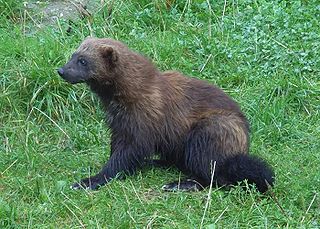 W
WThe wolverine, Gulo gulo, also referred to as the glutton, carcajou, skunk bear, or quickhatch, is the largest land-dwelling species of the family Mustelidae. It is a stocky and muscular carnivore, more closely resembling a small bear than other mustelids. A solitary animal, it has a reputation for ferocity and strength out of proportion to its size, with the documented ability to kill prey many times larger than itself.